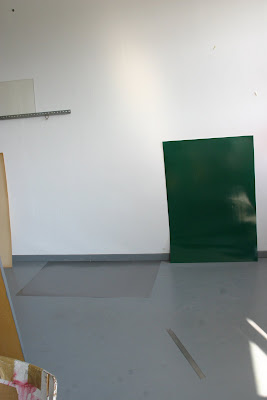Rachel Koolen
23/06/2009 13:57
hey Ruth I'm on line
Ruth Buchanan
23/06/2009 13:57
hi dear
23/06/2009 13:57
7 minutes, just need to arrange something with jo hardy...
Rachel Koolen
23/06/2009 13:58
good, talk to you later
Ruth Buchanan
23/06/2009 13:58
talk soon...
Rachel Koolen
23/06/2009 14:05
Well, 'll just start anyway, I like a slow beginning. It's possible I stay slow throughout conversation, have to go through my tax papers this afternoon.
23/06/2009 14:05
I liked your short proposal in yesterday's email----
I think we should totally propose something like this as a host strucutre, a table+shelf+display wall/leaning wall- combi of images a sound piece and video, simple strong statements. In London we got these kind of Ikea tables specified by using various table tops- perspex, lino and mirror, I think a coloured perspex one would be great- perhaps wiht monitor underneath on the floor a small shelf above with a sound piece coming out of a brocoli and another perspex leaning against the wall with coated metal or wood...??
23/06/2009 14:08
I can imagine how a table covered with colored acrylic and Video Class-video underneath it could work out really well. In that same line of thought the broccoli that is speaking on a mirror-shelf.
23/06/2009 14:10
They both are clear statements in the way you can easily describe and name there positions, almost like a caricature.
23/06/2009 14:12
Since I've been working with this table arrangement and describing the ink-jet prints as saturated and congealed, I would place these two before-mentioned suggestions within that category as well.
23/06/2009 14:17
Then the next question would be how they would enter into a dialogue with their surroundings. I'm looking for things that are less clearly outlined, I think. Perhaps as you would say: tilted - seeping - flickering - blurred edges/ light astray/ periphery - shadows - movement - touch - billowing.
23/06/2009 14:30
I'm wondering if Jens gets these messages as well once I've added him to my chat list. Don't think so, because there's always just one person selected.
Ruth Buchanan
23/06/2009 14:30
Hi R
23/06/2009 14:30
i'm not usre if Jens gets this as well?
23/06/2009 14:30
I think we can forward it to him?
23/06/2009 14:31
i think we can't add him since he has the black moon next to his name...!
Rachel Koolen
23/06/2009 14:32
I accepted him as my contact, no what. Oh, that could be the 'problem'
Ruth Buchanan
23/06/2009 14:32
i have hm as a contact now, but when i ask to add him to my chat it doesn't let me...but shall we call?
23/06/2009 14:33
or maybe typing is easier?
Rachel Koolen
23/06/2009 14:33
no. let's wait and chat a little bit more before..
23/06/2009 14:34
Did many peoples form JvE join the tour? staff, advising, researchers?
Ruth Buchanan
23/06/2009 14:34
I think the basic proposition of a surface that is both reflective and absorbing and also open (with nothing on it) implicates the surrounding space in that way, in that it is sucked and warped
23/06/2009 14:35
this implicating the surrounding space could also be exagerrated by placing surfaces like that around the space
23/06/2009 14:35
either tilting or leaning, or much more dramatic coul be to use the mirror trick that I have done from time to time,
23/06/2009 14:35
this could be a very elegant combinatino
Rachel Koolen
23/06/2009 14:35
Yes, but the relation is not specific, as it would be when you lay images out on a table.
Ruth Buchanan
23/06/2009 14:36
table with acrylic, video monitor underneath, mirror shelf with brocoli and mirrored tilt else where
23/06/2009 14:37
so you would say tha tputtng images on top of the coloured perspex surface implicates the surrounding space more?
23/06/2009 14:37
or more specifically?
Rachel Koolen
23/06/2009 14:38
No, it's just an example, a bit like you described in your tour, when putting images on a tabletop
Ruth Buchanan
23/06/2009 14:38
in this case I'm not sure- since by placing this surface above/below/between a voice and an acting body seems to me a force of implication- it becomes a structure that unites these two gestures (though colour and a a nod to archiecture) and then strteches out
23/06/2009 14:39
i think both those works- the video class and build a wall speak to and address there surrounding anyway
23/06/2009 14:39
...?
23/06/2009 14:43
Or we coudl suggest that we both come for 2 days or so with a bunch of materia and just stand around organising it on the table??
Rachel Koolen
23/06/2009 14:45
Yes I see how they could work together quite specifically. But with images, as an example from experience, there's a relation where 1 cm to the side or up matters. But I don't know, perhaps I need to see a gap, an undermining of these clear statements, more fragmentation. No, I don't think images are the solution necessarily
Ruth Buchanan
23/06/2009 14:46
im just wondering in the context of a group show it might not be better to work with rather strong statements that create a flickering
23/06/2009 14:46
both pieces, in combi with a perspex surface and maybe mirror do that
23/06/2009 14:47
strong statments but that rely on the shifting of light and proxmity to address the viewer?
Rachel Koolen
23/06/2009 14:48
Perhaps, but there are not so many modes of viewing or approaching the work e.g. mode of reading.
Ruth Buchanan
23/06/2009 14:49
what do you mean?
Rachel Koolen
23/06/2009 14:49
Close-up, absorption versus something else outside
Ruth Buchanan
23/06/2009 14:50
hey do you get this message from jens?
Rachel Koolen
23/06/2009 14:50
no,
23/06/2009 14:56
hi ruth
23/06/2009 14:56
are you there
Ruth Buchanan
23/06/2009 15:00
toilet
23/06/2009 15:00
im back now
_2.jpg)

















































